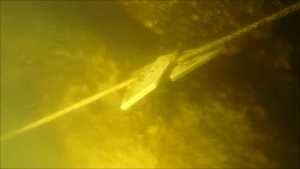Navigate Caves Safely with Line Protocol Mastery

One of the main reasons for cave diving fatalities involves the lack of continuous guidelines. Guidelines are the lifelines used by cave divers to reference the exit in underwater caves. The guideline leads the way to the cave entrance, back to the surface, and ambient air when visibility is lost. It can be either for not running a temporary line from the open water to the permanent guideline or passing from one line to another.
For maximum safety, cave divers follow continuous guidelines to lead them to the surface, even in total darkness. Directional markers such as arrows and personal non-directional markers such as “cookies” or REMs on the lines indicate the exit.
Permanent Lines
Permanent lines are installed in the cave to ensure a properly installed guideline for further exploration and visiting cave divers.
The permanent lines are often referred to as the mainline. They can begin close to the cave exit or further, hidden from open water divers, and prevent them from entering without proper training. Divers travel to the mainline with a primary reel to keep a continuous guideline from the open water.
Navigation in Caves
Ts
There is more than one permanent line in most caves, especially in the Yucatan peninsula in Mexico. Therefore, the divers have to navigate inside the cave. There are permanent intersections, referred to as a “T. “
Jumps
Sometimes, a diver has to move physically from one line to another; this is a jump. It can go from the end of one line to the middle of another or from the middle of a line to the end or middle of another.
Gaps
A gap goes from the end of one line to the end of another.
Personal line markers properly mark the exit. It has to be straightforward to be understood in zero visibility. The diver will be able to find the way to the open water area of the cave entrance.
Gap and Jump Lines
Divers must install a temporary gap or jump line to go from one line to another. Line markers, such as directional or non-directional, should also indicate and mark the exit.

Line Markers
Line markers indicate directions or mark surveys or science stations. They can be directional (arrows) or non-directional markers (cookies, clothespins, REM). Personal non-directional markers mark locations or exits and will not confuse other teams.
Laying line in a cave
Proper use of reels and placement of lines is essential for efficient cave diving. The line has to be laid, maintaining tension. The diver should place it close to the cave floor so divers can swim above it.
A primary tie-off should be made in open water where a direct ascent to the surface is possible. A secondary tie-off follows it in the cavern zone. Should the primary tie-off come loose, the second one will keep the line in place. Further, the diver must make a tie-off or placement whenever changing direction to avoid line traps.
During your Cave Diving Training, you will learn more about guidelines and line markers and practice their uses in real caves and various scenarios.

